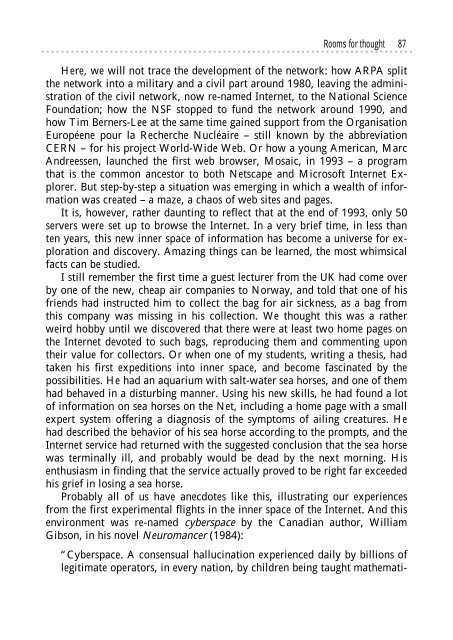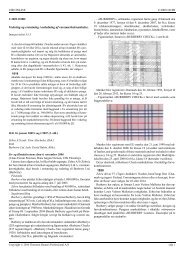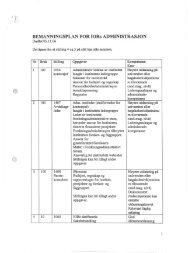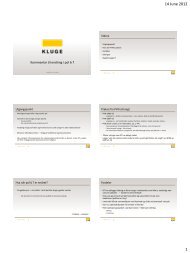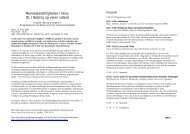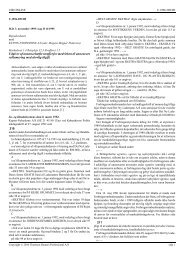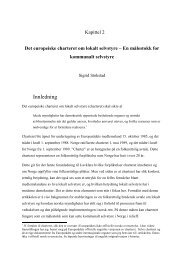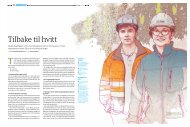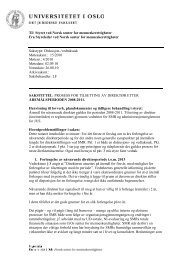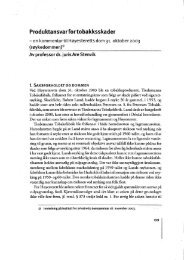Lee A. Bygrave (red.) YULEX 2002 - Universitetet i Oslo
Lee A. Bygrave (red.) YULEX 2002 - Universitetet i Oslo
Lee A. Bygrave (red.) YULEX 2002 - Universitetet i Oslo
Create successful ePaper yourself
Turn your PDF publications into a flip-book with our unique Google optimized e-Paper software.
............................................................................<br />
Rooms for thought 87<br />
Here, we will not trace the development of the network: how ARPA split<br />
the network into a military and a civil part around 1980, leaving the administration<br />
of the civil network, now re-named Internet, to the National Science<br />
Foundation; how the NSF stopped to fund the network around 1990, and<br />
how Tim Berners-<strong>Lee</strong> at the same time gained support from the Organisation<br />
Européene pour la Recherche Nucléaire – still known by the abbreviation<br />
CERN – for his project World-Wide Web. Or how a young American, Marc<br />
Andreessen, launched the first web browser, Mosaic, in 1993 – a program<br />
that is the common ancestor to both Netscape and Microsoft Internet Explorer.<br />
But step-by-step a situation was emerging in which a wealth of information<br />
was created – a maze, a chaos of web sites and pages.<br />
It is, however, rather daunting to reflect that at the end of 1993, only 50<br />
servers were set up to browse the Internet. In a very brief time, in less than<br />
ten years, this new inner space of information has become a universe for exploration<br />
and discovery. Amazing things can be learned, the most whimsical<br />
facts can be studied.<br />
I still remember the first time a guest lecturer from the UK had come over<br />
by one of the new, cheap air companies to Norway, and told that one of his<br />
friends had instructed him to collect the bag for air sickness, as a bag from<br />
this company was missing in his collection. We thought this was a rather<br />
weird hobby until we discove<strong>red</strong> that there were at least two home pages on<br />
the Internet devoted to such bags, reproducing them and commenting upon<br />
their value for collectors. Or when one of my students, writing a thesis, had<br />
taken his first expeditions into inner space, and become fascinated by the<br />
possibilities. He had an aquarium with salt-water sea horses, and one of them<br />
had behaved in a disturbing manner. Using his new skills, he had found a lot<br />
of information on sea horses on the Net, including a home page with a small<br />
expert system offering a diagnosis of the symptoms of ailing creatures. He<br />
had described the behavior of his sea horse according to the prompts, and the<br />
Internet service had returned with the suggested conclusion that the sea horse<br />
was terminally ill, and probably would be dead by the next morning. His<br />
enthusiasm in finding that the service actually proved to be right far exceeded<br />
his grief in losing a sea horse.<br />
Probably all of us have anecdotes like this, illustrating our experiences<br />
from the first experimental flights in the inner space of the Internet. And this<br />
environment was re-named cyberspace by the Canadian author, William<br />
Gibson, in his novel Neuromancer (1984):<br />
“Cyberspace. A consensual hallucination experienced daily by billions of<br />
legitimate operators, in every nation, by children being taught mathemati-


